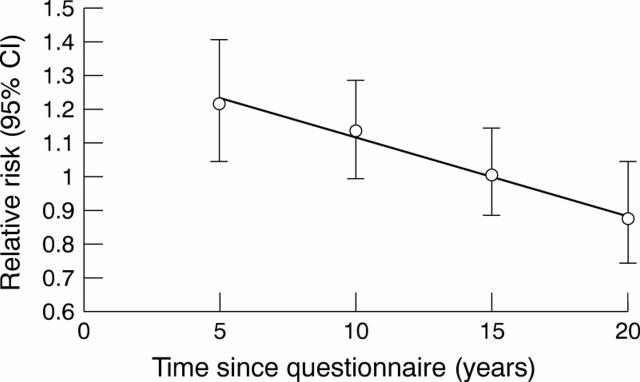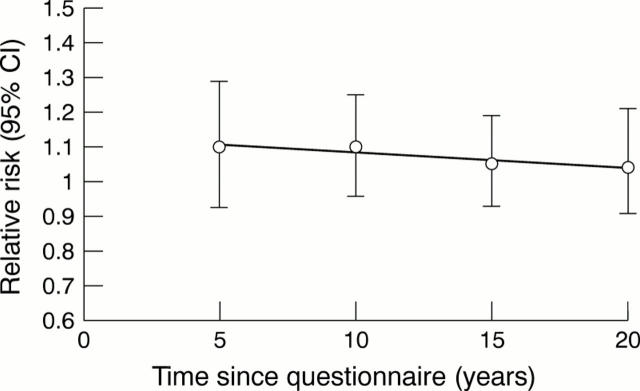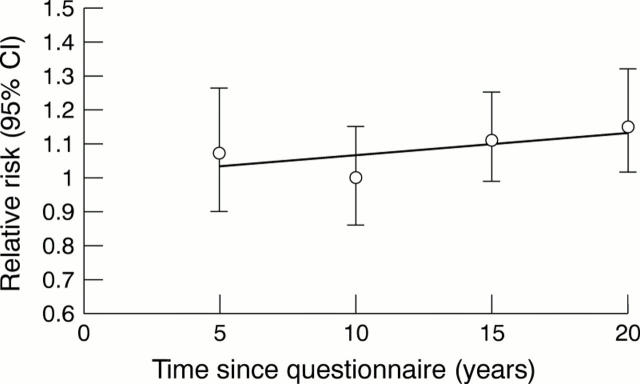Abstract
OBJECTIVE—To determine the relation between psychological characteristics and subsequent fatal ischaemic heart disease (IHD) events. DESIGN—Prospective study of participants in the Northwick Park heart study (NPHS) recruited between 1972 and 1978 and followed up for fatal events until 1997. SETTING—Three occupational groups in north west London. SUBJECTS—1408 white men without a history of myocardial infarction aged 40-64 years at entry who completed a Crown-Crisp experiential index form (CCEI). MAIN OUTCOME MEASURE—Fatal IHD during follow up. RESULTS—A one point increase in the score on the obsessionality/obsessional neurosis subscale was associated with a relative risk of fatal IHD of 1.08 (95% confidence interval (CI) 1.02 to 1.15). For the functional somatic complaint subscale the relative risk was also 1.08 (95% CI 1.02 to 1.15). In the case of the total score the relative risk of fatal IHD was 1.28 (95% CI 1.09 to 1.50) for a 10 point increase. The associations were independent of age, social class, and known cardiovascular risk factors. In the case of phobic anxiety, which had previously been found to be associated with fatal IHD in NPHS, the association was evident in the first 10 years of follow up but overall the relative risk was only 1.07 (95% CI 0.99 to 1.15) for a one point increase in the score. CONCLUSION—Scores on two of the subscales of the CCEI and the total score are significantly associated with fatal IHD on long term follow up independently of other known risk factors. Keywords: cohort study; ischaemic heart disease; psychological factors
Full Text
The Full Text of this article is available as a PDF (112.3 KB).
Figure 1 .
Trend of the relative risk (with 95% CI ) of fatal ischaemic heart disease for a one point change of the score on the phobic anxiety subscale over the period of follow up (p = 0.02).
Figure 2 .
Trend of relative risk (with 95% CI) of fatal ischaemic heart disease for a one point change of the score on the obsessionality/obsessional neurosis subscale over the period of follow up.
Figure 3 .
Trend of relative risk (with 95% CI) of fatal ischaemic heart disease for a one point change of score on the functional somatic complaint subscale over the period of follow up.
Selected References
These references are in PubMed. This may not be the complete list of references from this article.
- Boltwood M. D., Taylor C. B., Burke M. B., Grogin H., Giacomini J. Anger report predicts coronary artery vasomotor response to mental stress in atherosclerotic segments. Am J Cardiol. 1993 Dec 15;72(18):1361–1365. doi: 10.1016/0002-9149(93)90180-k. [DOI] [PubMed] [Google Scholar]
- Burg M. M., Jain D., Soufer R., Kerns R. D., Zaret B. L. Role of behavioral and psychological factors in mental stress-induced silent left ventricular dysfunction in coronary artery disease. J Am Coll Cardiol. 1993 Aug;22(2):440–448. doi: 10.1016/0735-1097(93)90048-6. [DOI] [PubMed] [Google Scholar]
- Crisp A. H., McGuiness B. Jolly fat: relation between obesity and psychoneurosis in general population. Br Med J. 1976 Jan 3;1(6000):7–9. doi: 10.1136/bmj.1.6000.7. [DOI] [PMC free article] [PubMed] [Google Scholar]
- Crisp A. H., Priest R. G. Psychoneurotic status during the year following bereavement. J Psychosom Res. 1972 Aug;16(5):351–355. doi: 10.1016/0022-3999(72)90088-8. [DOI] [PubMed] [Google Scholar]
- Crisp A. H., Queenan M., D'Souza M. F. Myocardial infarction and the emotional climate. Lancet. 1984 Mar 17;1(8377):616–619. doi: 10.1016/s0140-6736(84)91008-0. [DOI] [PubMed] [Google Scholar]
- Crown S., Crisp A. H. A short clinical diagnostic self-rating scale for psychoneurotic patients. The Middlesex Hospital Questionnaire (M.H.Q.). Br J Psychiatry. 1966 Sep;112(490):917–923. doi: 10.1192/bjp.112.490.917. [DOI] [PubMed] [Google Scholar]
- Enright S. J. Cognitive behaviour therapy--clinical applications. BMJ. 1997 Jun 21;314(7097):1811–1816. doi: 10.1136/bmj.314.7097.1811. [DOI] [PMC free article] [PubMed] [Google Scholar]
- Haines A. P., Imeson J. D., Meade T. W. Phobic anxiety and ischaemic heart disease. Br Med J (Clin Res Ed) 1987 Aug 1;295(6593):297–299. doi: 10.1136/bmj.295.6593.297. [DOI] [PMC free article] [PubMed] [Google Scholar]
- Haines A. P., Imeson J. D., Meade T. W. Psychoneurotic profiles of smokers and non-smokers. Br Med J. 1980 Jun 14;280(6229):1422–1422. doi: 10.1136/bmj.280.6229.1422. [DOI] [PMC free article] [PubMed] [Google Scholar]
- Hemingway H., Marmot M. Evidence based cardiology: psychosocial factors in the aetiology and prognosis of coronary heart disease. Systematic review of prospective cohort studies. BMJ. 1999 May 29;318(7196):1460–1467. doi: 10.1136/bmj.318.7196.1460. [DOI] [PMC free article] [PubMed] [Google Scholar]
- Kawachi I., Colditz G. A., Ascherio A., Rimm E. B., Giovannucci E., Stampfer M. J., Willett W. C. Prospective study of phobic anxiety and risk of coronary heart disease in men. Circulation. 1994 May;89(5):1992–1997. doi: 10.1161/01.cir.89.5.1992. [DOI] [PubMed] [Google Scholar]
- Kawachi I., Sparrow D., Vokonas P. S., Weiss S. T. Decreased heart rate variability in men with phobic anxiety (data from the Normative Aging Study). Am J Cardiol. 1995 May 1;75(14):882–885. doi: 10.1016/s0002-9149(99)80680-8. [DOI] [PubMed] [Google Scholar]
- Kubzansky L. D., Kawachi I. Going to the heart of the matter: do negative emotions cause coronary heart disease? J Psychosom Res. 2000 Apr-May;48(4-5):323–337. doi: 10.1016/s0022-3999(99)00091-4. [DOI] [PubMed] [Google Scholar]
- Kubzansky L. D., Kawachi I., Weiss S. T., Sparrow D. Anxiety and coronary heart disease: a synthesis of epidemiological, psychological, and experimental evidence. Ann Behav Med. 1998 Spring;20(2):47–58. doi: 10.1007/BF02884448. [DOI] [PubMed] [Google Scholar]
- Meade T. W., North W. R., Chakrabarti R., Haines A. P., Stirling Y. Population-based distributions of haemostatic variables. Br Med Bull. 1977 Sep;33(3):283–288. doi: 10.1093/oxfordjournals.bmb.a071448. [DOI] [PubMed] [Google Scholar]
- Meade T. W., North W. R., Chakrabarti R., Stirling Y., Haines A. P., Thompson S. G., Brozovié M. Haemostatic function and cardiovascular death: early results of a prospective study. Lancet. 1980 May 17;1(8177):1050–1054. doi: 10.1016/s0140-6736(80)91498-1. [DOI] [PubMed] [Google Scholar]
- Thompson S. G. Predicting myocardial infarction. Lancet. 1984 May 5;1(8384):1021–1022. doi: 10.1016/s0140-6736(84)92365-1. [DOI] [PubMed] [Google Scholar]





